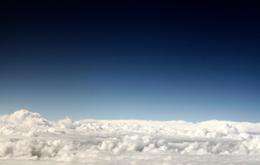New isotope cluster could lead to better understanding of atmospheric carbon dioxide

(PhysOrg.com) -- A team of researchers has discovered an unexpected concentration of a certain isotopic molecule in parts of the stratosphere that could have implications for understanding the carbon cycle and its response to climate change.
By analyzing samples of air taken from the stratosphere—the layer of Earth's atmosphere that sits between six and 30 miles above the surface—the team found a much higher concentration of 16O13C18O at high latitudes than expected. They report their finding in the July 14 issue of the Proceedings of the National Academy of Sciences.
The concentration of different isotopes is the result of different processes that carbon dioxide undergoes, such as in photosynthesis. As such, isotopes act as carbon dioxide "tracers," said Hagit Affek, an assistant professor of geology and geophysics at Yale University who previously worked as part of the lead team at the California Institute of Technology. "We use isotopes to 'balance the budget' of the carbon cycle. They basically act like labels that tell us where the carbon dioxide is coming from and where it's going."
While a postdoctoral associate at Caltech, Affek had found unexpectedly low concentrations of 16O13C18O in surface samples of air taken during the winter, and was looking for correspondingly low levels in the stratosphere. Instead, she was surprised to discover elevated concentrations in the stratosphere over the Earth's arctic region.
Although the scientists cannot yet explain the result, they propose two potential explanations. The first is that the high levels of the isotope cluster could be the result of air from the stratosphere mixing with air from the mesosphere—the layer above the stratosphere. The second is that an interaction between carbon dioxide and stratospheric water molecules could produce this abundance of 16O13C18O.
Either way, the results have implications for understanding the chemical reactions involving carbon dioxide—a greenhouse gas—that take place in the atmosphere, Affek said.
As an example, Affek pointed out that if the boreal forest absorbs more carbon dioxide than the rainforest, it could tell us something about where we should aim our conservation efforts. Also, as climate change warms the planet's oceans, they will be less able to take up carbon dioxide.
"We need to understand how much carbon dioxide we can produce before the oceans and plants can't absorb anymore," Affek said.
Source: Yale University (news : web)















